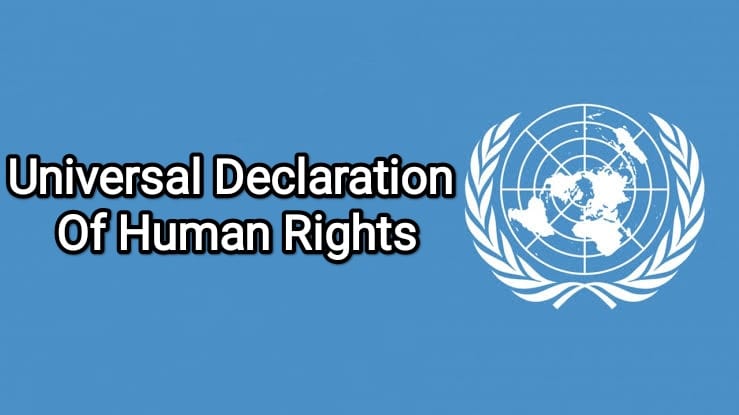Universal Declaration Of Human Rights PDF Free Download
In a world that encompasses diverse cultures, backgrounds, and beliefs, the Universal Declaration of Human Rights (UDHR) stands as a beacon of hope and progress. Crafted in the aftermath of World War II, the UDHR represents a global commitment to safeguarding the inherent dignity and rights of every individual. This comprehensive document has played a pivotal role in shaping international law and fostering a more just and equitable world.

Introduction
The Universal Declaration of Human Rights, adopted by the United Nations General Assembly on December 10, 1948, marked a significant turning point in global history. In the wake of unprecedented atrocities during World War II, the world recognized the need to prevent such horrors from recurring.
Historical Context: Post-World War II Realities
The devastation caused by World War II underscored the urgency of establishing a framework that upholds fundamental human rights. The horrors of the Holocaust and other atrocities led to a collective realization that humanity could no longer ignore the need to protect individuals from abuses and injustices.
Crafting the Declaration: Collaborative Efforts
The drafting of the UDHR was a collaborative endeavor involving representatives from diverse cultural backgrounds and legal traditions. Under the leadership of Eleanor Roosevelt, the Commission on Human Rights worked tirelessly to create a document that transcends borders and speaks to the shared values of all nations.
The Pillars of Human Rights
The Right to Life and Liberty (Article 3)
Article 3 of the UDHR emphasizes the inherent right to life, liberty, and security. It asserts that every individual has the right to live without fear of arbitrary deprivation of life.
Freedom from Torture and Slavery (Article 5)
Article 5 prohibits torture, cruel, inhuman, or degrading treatment or punishment. It also condemns slavery and servitude in all forms.
Right to Equality (Article 7)
Article 7 declares that all are equal before the law and are entitled to equal protection against discrimination. It enshrines the principle that everyone is entitled to equal protection under the law without any discrimination.
Right to a Fair Trial (Article 10)
Article 10 ensures the right to a fair and public hearing by an impartial tribunal. It emphasizes that justice should be administered without bias or favoritism.
Economic, Social, and Cultural Rights
Right to Work and Education (Article 23)
Article 23 recognizes the right to work, just and favorable conditions of work, and the right to education. It underscores the importance of these rights in achieving a dignified life.
Right to Adequate Living Standard (Article 25)
Article 25 acknowledges the right to a standard of living adequate for health and well-being, including food, clothing, housing, and medical care.
Also Read This : Music For Sight Singing 10th Edition PDF
Ensuring Rights: Challenges and Progress
Addressing Gender Inequality
While the UDHR laid the foundation for gender equality, challenges persist. Efforts continue to bridge the gender gap and empower women to fully participate in all aspects of society.
Combating Racial Discrimination
The UDHR condemns racial discrimination and promotes understanding among different racial and ethnic groups. However, the fight against racism and prejudice remains ongoing.
The Impact of the UDHR
Inspirational Movements
The UDHR has inspired numerous movements advocating for human rights and social justice, including civil rights, women’s rights, and LGBTQ+ rights.
Legal Framework for Human Rights
The declaration has served as a basis for the development of international human rights law, shaping treaties and conventions that hold nations accountable for protecting their citizens’ rights.
Criticisms and Challenges
Cultural Relativism
Critics argue that universal human rights may clash with cultural norms. Striking a balance between cultural diversity and fundamental rights remains a complex challenge.
Enforcement and Accountability
Enforcement mechanisms for human rights remain a concern, as some nations prioritize sovereignty over complying with international standards.
Looking Ahead: The Unfinished Agenda
As society evolves, so do the challenges to human rights. Addressing emerging issues such as digital privacy, climate change, and AI ethics requires a renewed commitment to the principles of the UDHR.
Conclusion
The Universal Declaration of Human Rights stands as a testament to humanity’s aspiration for a more just and compassionate world. While challenges persist, the document’s enduring impact reminds us of our shared responsibility to protect the dignity and rights of all individuals.
FAQs
Que : What is the Universal Declaration of Human Rights?
Ans : The Universal Declaration of Human Rights is a milestone document adopted by the United Nations that outlines fundamental human rights for all individuals.
Que : How does the UDHR promote equality?
Ans : The UDHR promotes equality by asserting the right to equal protection under the law and condemning discrimination in all its forms.
Que : Why is the UDHR significant today?
Ans : The UDHR’s principles remain relevant as a guide for creating inclusive societies and addressing contemporary challenges.
Que : Can the UDHR be enforced legally?
Ans : While not a binding treaty, the UDHR has influenced the development of legally binding treaties and conventions that uphold human rights.
Que : What are the challenges to implementing the UDHR?
Ans : Challenges include cultural differences, enforcement difficulties, and adapting to new technological and environmental issues.
Click Here To Download PDF For Free








